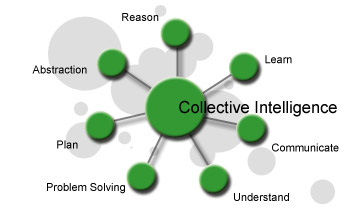Recently one of my clients introduced a 360 Review to their leadership team coupled with a six month Topgrading Evaluation. The latter process involves using the same Job Summary Scorecard used to hire someone for the position to evaluate the performance of the current position holder. It’s great because it serves two purposes and allows you to evaluate how the person is performing against your “A” standards you’ve previously setup. The 360 is a look inside those people who should know you the best in your management position. It asks to score you on several leadership and management qualities so you can get their view of your capabilities. If you have not done a 360 on your leadership team or yourself, I’d encourage you to do so. Here’s why:
 Each Leadership team member including the CEO was reviewed by the staff in the following ten areas: Leadership, Planning & Managing Achievement, Flexibility, Collaboration, Innovation, Risk Management, Organizational Sensitivity, Strategic Thinking, Managing Customers, Networking, and Personal Impact. Grade levels were on a scale of 1 through 7, with the bottom level extremely poor and the top level excellent. There were also categories for Not Applicable, and Don’t Know, in case the evaluator had not had an experience with the person or simply had no context to grade them.
Each Leadership team member including the CEO was reviewed by the staff in the following ten areas: Leadership, Planning & Managing Achievement, Flexibility, Collaboration, Innovation, Risk Management, Organizational Sensitivity, Strategic Thinking, Managing Customers, Networking, and Personal Impact. Grade levels were on a scale of 1 through 7, with the bottom level extremely poor and the top level excellent. There were also categories for Not Applicable, and Don’t Know, in case the evaluator had not had an experience with the person or simply had no context to grade them.
Participants were also asked to comment on three questions:
What are this Manager's Strengths?
What are this Manager's Weaknesses?
What Steps does this Manager need to take to increase his or her skills as a Manager?
I must warn you that the process of reviewing the 360’s as well as the Topgrading Evaluation is time consuming. To perform both required a minimum of 90 minutes with each process. In some cases the participant required longer as we dove into some aspects that required more attention seeking to solve some deep rooted issues.
Only if your business and your leadership team is truly committed to growth and self-improvement should you decide to undertake this. Only a business that is truly committed to its people would invest the time to complete this arduous yet rewarding engagement.
A link was set up to allow everyone to provide their score anonymously. Once the results were received the outcome is provided to the leadership team member ahead of their meeting. My customer did the meetings in tandem with the CEO and I providing observations and input along with taking notes from the meeting. The first step is to review the grades and determine the validity of the scores from the individual’s perspective. It is one thing to hear an employee you’re supervising make a comment, it’s quite another to see the results of them scoring you on these leadership skills and have several others agree. That includes positive and negative results.
Are your people truly interested in improving their performance and ability to manage and lead? I can tell you each of the leadership team members I sat in on were excited to get this feedback. They truly are invested in their future. They were eager to see the results and willing to discover where they can improve their leadership styles.
We’ve discussed the idea of Priority, The One Thing focus that we emphasize with our customers in coaching them to grow. The same target is ideal for growth and improvement generated from the results of the 360 reviews.
While there are arguments and discussions about some of the results, at least in our meetings there was always agreement from the leadership member on some aspect where they could improve. The key is developing a plan to initiate and make that change occur.
The 360 Action Plan is precisely for this. It asks the individual to assess the results, brainstorm ideas for correcting or improving a behavior, discover obstacles and support for making the improvement, and then to take specific steps to achieve the desired change. It asks for whom you will have support you, how you might reward yourself for achieving the desired result and finally a commitment statement as to what you wish to achieve. The emphasis here is on focusing to improve or change one thing.
Most importantly this isn’t intended to be a canvas of commitments and changes, rather a focus on one change, one improvement, one acknowledged area that you, your team members you supervise, and your peers agree that would make a difference in the quality of your leadership ability. One Thing is the priority.
Most people will want to change multiple elements. I urge you to suppress their ambition for doing this. More progress will be made focusing on one change or performance improving skill set than by selecting more. Indeed it’s likely that other scores will improve by simply improving one area.
If you’re looking for questions to ask in a 360 you can ask Positioning Systems for help or search the web or articles like Sample Questions for 360 Reviews. It’s important to ask the right questions, yet without a dedicated desire to improve and an action plan to follow the possibility of achieving any results from this exhausting exercise will be precious little. Furthermore without an impact from this the likelihood of those who participated enthusiastically responding again greatly diminishes.
If you’re going to launch this process you should do so with the commitment from the people being reviewed that they intend to utilize the results and make measureable improvements in their behavior and skills from the feedback received. Otherwise the gains from this will be negligible now and for the future.
Do you have a leadership team that is sincerely committed to improving? Are you looking for a tool that provides feedback to expose and discover aspects of leadership and management that will help them improve their performance? Consider the 360 Review/Feedback.
It’s too early to tell the outcome from these initial meetings but judging by the tenor and tone of the meetings, plus the degree of commitment I felt from these leadership team members, I’ll be very surprised if this leadership team doesn’t take a dramatic step forward in their performance and ability to lead their teams.
You can download an example of the 360 in Action to provide your team with a way to take action on their results. Ask Positioning Systems if you’d like help initiating this growth exercise tool in your business.

 Solving issues, challenges, concerns, and simple brainstorming by calling on the
Solving issues, challenges, concerns, and simple brainstorming by calling on the  In my client meetings many occasions of perfect synchronicity occur that remind me of the powerfulness of building Strategic Discipline into the fabric of business structure. A recent monthly meeting provided a reminder to the powerful impact that simple recognition offers to feed employees souls.
In my client meetings many occasions of perfect synchronicity occur that remind me of the powerfulness of building Strategic Discipline into the fabric of business structure. A recent monthly meeting provided a reminder to the powerful impact that simple recognition offers to feed employees souls.  Making good decisions in these challenging times requires leadership that listens to their employees and customers for feedback and then has the courage to change. The following is an example of one of my clients who has consistently beaten challenges and recently made a remarkable innovation that required considerable risk. First a little background on All County Music and Fred Schiff’s leadership capabilities.
Making good decisions in these challenging times requires leadership that listens to their employees and customers for feedback and then has the courage to change. The following is an example of one of my clients who has consistently beaten challenges and recently made a remarkable innovation that required considerable risk. First a little background on All County Music and Fred Schiff’s leadership capabilities. Fred intuitively understood (quoted in an article from Music Inc), “There are certain parts of the market that want to be niche, where [customers] want to experience something they can’t get somewhere else.” Investment in this innovation was $10,000 not including his stock.
Fred intuitively understood (quoted in an article from Music Inc), “There are certain parts of the market that want to be niche, where [customers] want to experience something they can’t get somewhere else.” Investment in this innovation was $10,000 not including his stock. Accessory and flute service repairs have far exceeded is projections. The initial investment has been earned back.
Accessory and flute service repairs have far exceeded is projections. The initial investment has been earned back.